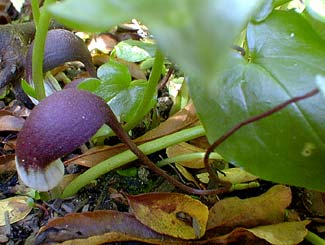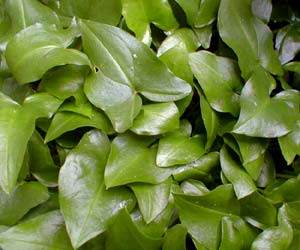
Mouse Plant
A woodland aroid native of Italy & Spain, Mouse Plant, or Mouse Tail Plant (Arisarum proboscideum), is a small cousin to Jack-in-the-Pulpit.
It does well in dryish shade, though if the soil entirely dries out at any time in spring, it may go prematurely dormant. Persistant moisture in extremely well-draining soil will suit it best.
Its gorgeous green arrowhead leaves form a low, spreading carpet beginning late in winter. It would be a pretty plant even without flowers. But it is the strange flowers that lend it its name. The long tail on each fat little spathes lends the flowers the appearance of a family of mice, enhanced by the chocolate-maroon coloration of the upper portion & tail. The lower portion of the spathe is white like a deermouse's belly.
 These flowers appear in mid to late April but are entirely hidden in the leaves, so that to appreciate the plant fully requires some interaction with the plant. If a gardener never thought to part the leaves, the flowers might well come & go never seen.
These flowers appear in mid to late April but are entirely hidden in the leaves, so that to appreciate the plant fully requires some interaction with the plant. If a gardener never thought to part the leaves, the flowers might well come & go never seen.I sometimes suspect our gardens are in places way too "introverted" rather than showy, & visitors might not appreciate as much as we do such things mouse plants & asarums with interesting blooms invisible beneath leaves, or hellebores with their showiness completely facing the ground. Fortunately we're not alone in liking introverted things. When four of Granny Artemis's out-of-state relatives came to town in April, we were delighted that everyone got down on their knees to part the mouseplant's leaves & many oos & ahs were shared.
For our two clumps, the leaves are fully developed by the time the mice appear. In colder zones the leaves start later in the season, & the mice may appear before the leaves entirely hide them immediately, but the leaves will soon enshroud the mouse family.
These ultra-charming blooms are not quite entirely hidden because the tails make them six or seven inches long, so that either the maroon tail, or occasionally a portion of the main body of the mouse, will poke out of the shiny green arrowhead foliage.
The mice are most numerous in April but may persist to the start of summer. The creeping clump of leaves outlast the flowers by quite some while, but will be dying to the ground by August, sooner if its essential well-drained humousy soil completely dries out. Be sure to mark the location well in order to not accidentally dig them up while they are dormant.
Hardy & easily grown, the main risk is excessive dampness rotting the tubers during autumn/winter dormancy. They do well in either sun or shade, but prefer bright shade. It grows from a tuber that develops rhizomes which develop more tubers & offsets, for a slowly expanding clump, never invasive but may after many years need to be lifted & divided.
I have wondered if this aroid shouldn't be regarded as partially carnivorous. The "tail" has a mushroom odor which is known to attract female fungus gnats as mouse tail pollinators. In the process the gnats lay their eggs in the mouse tail. These eggs hatch but the larvae fail to develop, having no actual fungus to eat. Possibly the fly larvae, starving while in pursuit of food inside the spathe, are also needed for full pollination. If the mouse plant happens to gain any degree of nutrient from the eggs & the dead larvae, that would qualify as carnivorous behavior.
But I've never seen this aspect of the Mouse Plant discussed in any detail, so perhaps it gets nothing from having the eggs left by its pollinator. I've wondered about this because it seems to me nothing is done for no reason by nature, & the Mouse Plant would seem to want those gnat eggs for some actual purpose. The reason the Mouse Plant blooms so early (sometimes ahead of its fully developed leaves) is it wants to get ahead of the actual mushrooms that will soon be attracting the same gnats. If not to any degree carniverous, the Mouse Plant is at least parasitic, in that it attracts pollinators it in no wise provides an exchanged benefit.